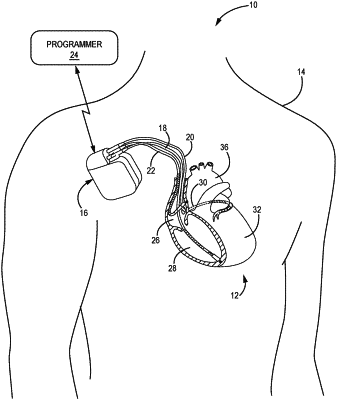| CPC A61B 5/0537 (2013.01) [A61B 5/0538 (2013.01); A61B 5/7275 (2013.01); A61N 1/36521 (2013.01); A61N 1/3702 (2013.01); A61N 1/37258 (2013.01)] | 12 Claims |

|
1. A medical system for determining whether a patient is at risk of exhibiting excessive fluid or dehydration and for delivering treatment in response thereto, the system comprising:
an implantable medical device having a device memory storing a patient's absolute intrathoracic impedance data over a time period, the implantable medical device comprising:
a plurality of electrodes; and
a processor configured to:
(a) determine an average of the absolute intrathoracic impedance data over the time period, wherein the absolute intrathoracic impedance data comprises raw impedance data measured between two electrodes of the plurality of electrodes, and wherein the average comprises a moving average;
(b) define a target impedance range having a lower bound and an upper bound, the lower bound defining a lower value intrathoracic electrical impedance and the upper bound defining a higher value intrathoracic electrical impedance;
(c) determine whether the average of the absolute intrathoracic impedance data is outside of the target impedance range; and
(d) in response to the average of the absolute intrathoracic impedance data being outside the target impedance range, determine a level of heart failure (HF) event risk;
(f) in response to step (d), instruct the implantable medical device to adjust therapy delivered to the patient wherein the therapy is adjusted by switching to one of fusion pacing, biventricular pacing, and multisite pacing delivered by the implantable medical device.
|